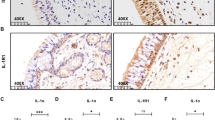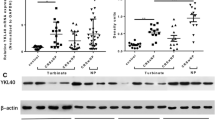Abstract
The pathophysiologic mechanisms of human chronic rhinosinusitis with nasal polyps (CRSwNP) remain unclear. We aimed to elucidate expression and biologic role of NLRP3 inflammasome in CRSwNP. Immunohistochemistry (IHC) was conducted to assess NLRP3 immunolabeling, real-time polymerase chain reaction (PCR) was used for IL-9 and NLRP3, and caspase-1 level quantitation in CRSwNP and control subjects. In addition, enzyme-linked immunosorbent assay (ELISA) was employed for analyzing concentrations of IL-1β and IL-18 in the homogenates prepared from tissue specimens. Moreover, human nasal epithelial cells (HNECs) were used to evaluate the effects of lipopolysaccharide (LPS) and glyburide on NLRP3 inflammasome signaling pathway. Results showed that NLRP3 and caspase-1 were overexpressed in CRSwNP, especially in eosinophilic CRSwNP (ECRSwNP). Interestingly, NLRP3 expression had close correlation to that of caspase-1. Concentrations of IL-1β and IL-18 were elevated. NLRP3 inflammasome signaling pathway was augmented by LPS but suppressed by glyburide. In conclusion, NLRP3 inflammasome signaling pathway played a pro-inflammatory role in the pathogenesis of CRSwNP, especially in ECRSwNP. NLRP3 inflammasome signaling pathway was augmented by LPS, but suppressed by glyburide.




Similar content being viewed by others
References
Wang, X., J. Du, and C. Zhao. 2014. Bacterial Biofilms are Associated with Inflammatory Cells Infiltration and the Innate Immunity in Chronic Rhinosinusitis With or Without Nasal Polyps. Inflammation 37(3): 871–9.
Wei, P., G.H. Hu, H.Y. Kang, et al. 2014. Role of the aryl hydrocarbon receptor in the pathogenesis of chronic rhinosinusitis with nasal polyps. Inflammation 37: 387–395.
Van Zele, T., S. Claeys, P. Gevaert, et al. 2006. Differentiation of chronic sinus diseases by measurement of inflammatory mediators. Allergy 61: 1280–1289.
Tomassen, P., T. Van Zele, N. Zhang, et al. 2011. Pathophysiology of chronic rhinosinusitis. Proceedings of the American Thoracic Society 8: 115–120.
Cao, P.P., H.B. Li, B.F. Wang, et al. 2009. Distinct immunopathologic characteristics of various types of chronic rhinosinusitis in adult Chinese. Journal of Allergy and Clinical Immunology 124: 478–484. 484 e471-472.
Claes, A.K., J.Y. Zhou, and D.J. Philpott. 2015. NOD-Like Receptors: Guardians of Intestinal Mucosal Barriers. Physiology (Bethesda) 30: 241–250.
Corridoni, D., K.O. Arseneau, M.G. Cifone, et al. 2014. The dual role of nod-like receptors in mucosal innate immunity and chronic intestinal inflammation. Frontiers in Immunology 5: 317.
Shao, B.Z., Z.Q. Xu, B.Z. Han, et al. 2015. NLRP3 inflammasome and its inhibitors: a review. Frontiers in Pharmacology 6: 262.
Perez-Figueroa, E., J. Torres, N. Sanchez-Zauco, et al. 2016. Activation of NLRP3 inflammasome in human neutrophils by Helicobacter pylori infection. Innate Immunity 22: 103–112.
Hughes Jr., F.M., H.M. Hill, C.M. Wood, et al. 2016. The NLRP3 Inflammasome Mediates Inflammation Produced by Bladder Outlet Obstruction. The Journal of Urology 195: 1598–1605.
Lee, M.S., H. Kwon, E.Y. Lee, et al. 2016. Shiga Toxins Activate the NLRP3 Inflammasome Pathway To Promote Both Production of the Proinflammatory Cytokine Interleukin-1beta and Apoptotic Cell Death. Infection and Immunity 84: 172–186.
Hosseinian, N., Y. Cho, R.F. Lockey, et al. 2015. The role of the NLRP3 inflammasome in pulmonary diseases. Therapeutic Advances in Respiratory Disease 9: 188–197.
Simpson, J.L., S. Phipps, K.J. Baines, et al. 2014. Elevated expression of the NLRP3 inflammasome in neutrophilic asthma. European Respiratory Journal 43: 1067–1076.
Im, H., and A.J. Ammit. 2014. The NLRP3 inflammasome: role in airway inflammation. Clinical and Experimental Allergy 44: 160–172.
Ather, J.L., K. Ckless, R. Martin, et al. 2011. Serum amyloid A activates the NLRP3 inflammasome and promotes Th17 allergic asthma in mice. Journal of Immunology 187: 64–73.
Birrell, M.A., and S. Eltom. 2011. The role of the NLRP3 inflammasome in the pathogenesis of airway disease. Pharmacology and Therapeutics 130: 364–370.
Fokkens, W.J., V.J. Lund, J. Mullol, et al. 2012. EPOS 2012: European position paper on rhinosinusitis and nasal polyps 2012. A summary for otorhinolaryngologists. Rhinology 50: 1–12.
Lin, H., D. Lin, X.S. Xiong, et al. 2014. Role of platelet-derived growth factor-alpha in eosinophilic and non-eosinophilic chronic rhinosinusitis with nasal polyps. Int Forum Allergy Rhinol 4: 909–914.
Lin, D., H. Lin, and X. Xiong. 2014. Expression and role of BAG-1 in eosinophilic and non-eosinophilic chronic rhinosinusitis with nasal polyps. Inflammation 37: 1912–1918.
Pei, J., W. Fu, L. Yang, et al. 2013. Oxidative stress is involved in the pathogenesis of Keshan disease (an endemic dilated cardiomyopathy) in China. Oxidative Medicine and Cellular Longevity 2013: 474203.
Bai, J., B. Miao, X. Wu, et al. 2015. Enhanced expression of SAM-pointed domain-containing Ets-like factor in chronic rhinosinusitis with nasal polyps. Laryngoscope 125: E97–103.
Ouyang, Y., E. Fan, Y. Li, et al. 2013. Clinical characteristics and expression of thymic stromal lymphopoetin in eosinophilic and non-eosinophilic chronic rhinosinusitis. ORL: Journal for Otorhinolaryngology and Its Related Specialties 75: 37–45.
Zou, Y., Y. Wang, S.B. Wang, et al. 2016. Characteristic expression and significance of CCL19 in different tissue types in chronic rhinosinusitis. Exp Ther Med 11: 140–146.
Jo, E.K., J.K. Kim, D.M. Shin, et al. 2016. Molecular mechanisms regulating NLRP3 inflammasome activation. Cellular and molecular immunology 13: 148–159.
Wu, J.X., and K.H. Shi. 2015. NLRP3, a Double-edged Sword in Lung Injury Diseases. Inflammation 38: 1855–1856.
Liu, Z., H. Zhao, W. Liu, et al. 2015. NLRP3 inflammasome activation is essential for paraquat-induced acute lung injury. Inflammation 38: 433–444.
Soyka, M.B., P. Wawrzyniak, T. Eiwegger, et al. 2012. Defective epithelial barrier in chronic rhinosinusitis: the regulation of tight junctions by IFN-gamma and IL-4. Journal of Allergy and Clinical Immunology 130(1087–1096): e1010.
Kook, J.H., H.J. Kim, K.W. Kim, et al. 2015. The expression of 11beta-hydroxysteroid dehydrogenase type 1 and 2 in nasal polyp-derived epithelial cells and its possible contribution to glucocorticoid activation in nasal polyp. American Journal of Rhinology & Allergy 29: 246–250.
Liao, B., P.P. Cao, M. Zeng, et al. 2015. Interaction of thymic stromal lymphopoietin, IL-33, and their receptors in epithelial cells in eosinophilic chronic rhinosinusitis with nasal polyps. Allergy 70: 1169–1180.
Mao, X., S. Sarkar, and S.L. Chang. 2013. Involvement of the NLRP3 inflammasome in the modulation of an LPS-induced inflammatory response during morphine tolerance. Drug and Alcohol Dependence 132: 38–46.
Ramani, V., and S. Awasthi. 2015. Toll-like receptor 4-interacting SPA4 peptide suppresses the NLRP3 inflammasome in response to LPS and ATP stimuli. Journal of Leukocyte Biology 98: 1037–1048.
Acknowledgments
This work was supported by Fujian Provincial Natural Science Foundation of China (No. 2010 J01215 and No. 2015 J01302).
Author information
Authors and Affiliations
Corresponding authors
Ethics declarations
This study was approved by the ethical committees of Shanghai Jiao Tong University Affiliated Sixth People’s Hospital and Fuzhou General Hospital, and an informed consent was provided from every subject.
Additional information
Hai Lin, Zhipeng Li and Dong Lin contributed equally to this work.
Rights and permissions
About this article
Cite this article
Lin, H., Li, Z., Lin, D. et al. Role of NLRP3 Inflammasome in Eosinophilic and Non-eosinophilic Chronic Rhinosinusitis with Nasal Polyps. Inflammation 39, 2045–2052 (2016). https://doi.org/10.1007/s10753-016-0442-z
Published:
Issue Date:
DOI: https://doi.org/10.1007/s10753-016-0442-z




